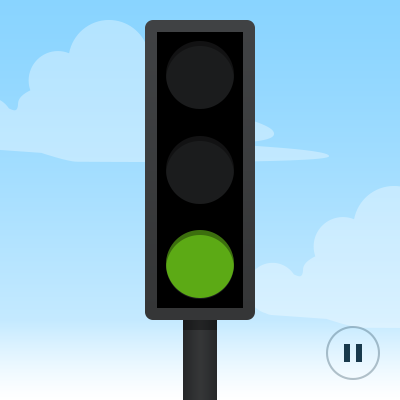SCXML Traffic Light (Static, Widgets)
A widget-based application that uses a compiled state machine to implement a traffic light.

Traffic Light Example (Static) demonstrates how to connect to the active properties of a state in a state machine that is compiled to a class.
The UI is created using Qt Widgets.
Running the Example
To run the example from Qt Creator, open the Welcome mode and select the example from Examples. For more information, visit Building and Running an Example.
Compiling the State Machine
We link against the Qt SCXML module by adding the following lines to the example's build files.
.pro when using qmake:
QT += qml scxml
We then specify the state machine to compile:
STATECHARTS = ../trafficlight-common/statemachine.scxml
CMakeLists.txt when using cmake:
find_package(Qt6 REQUIRED COMPONENTS Core Gui Qml Scxml) target_link_libraries(trafficlight-qml-static PRIVATE Qt6::Core Qt6::Gui Qt6::Qml Qt6::Scxml )
We then specify the state machine to compile:
qt6_add_statecharts(trafficlight-qml-static ../trafficlight-common/statemachine.scxml )
The statechart directives STATECHARTS or qt6_add_statecharts invoke the Qt SCXML Compiler, qscxmlc, which is run automatically to generate statemachine.h and statemachine.cpp, which are then added appropriately as headers and sources for compilation.
Instantiating the State Machine
We instantiate the generated TrafficLightStateMachine class in the trafficlight-widgets-static.cpp file, as follows:
#include "statemachine.h" #include "../trafficlight-common/trafficlight.h" #include <QtWidgets/qapplication.h> int main(int argc, char **argv) { QApplication app(argc, argv); TrafficLightStateMachine machine; TrafficLight widget(&machine); widget.show(); machine.start(); return app.exec(); }
Connecting to States
In the SCXML file, we specify states for each light: red, yellow, and green. In the <onentry> element, we specify the event to send when entering the state and the delay in seconds before sending the event. In the <transition> element, we specify the event that triggers the transition to the state specified by the target attribute:
<state id="red"> <onentry> <send event="startGoingGreen" delay="3s"/> </onentry> <transition event="startGoingGreen" target="redGoingGreen"/> </state> <state id="yellow" initial="greenGoingRed"> <state id="redGoingGreen"> <onentry> <send event="goGreen" delay="1s"/> </onentry> <transition event="goGreen" target="green"/> </state> <state id="greenGoingRed"> <onentry> <send event="goRed" delay="1s"/> </onentry> <transition event="goRed" target="red"/> </state> </state> <state id="green"> <onentry> <send event="startGoingRed" delay="3s"/> </onentry> <transition event="startGoingRed" target="greenGoingRed"/> </state>
We connect to the states as follows:
machine->connectToState(u"red"_s, widget->redLight(), &LightWidget::switchLight); machine->connectToState(u"redGoingGreen"_s, widget->redLight(), &LightWidget::switchLight); machine->connectToState(u"yellow"_s, widget->yellowLight(), &LightWidget::switchLight); machine->connectToState(u"blinking"_s, widget->yellowLight(), &LightWidget::switchLight); machine->connectToState(u"green"_s, widget->greenLight(), &LightWidget::switchLight);
© 2024 The Qt Company Ltd. Documentation contributions included herein are the copyrights of their respective owners. The documentation provided herein is licensed under the terms of the GNU Free Documentation License version 1.3 as published by the Free Software Foundation. Qt and respective logos are trademarks of The Qt Company Ltd. in Finland and/or other countries worldwide. All other trademarks are property of their respective owners.
